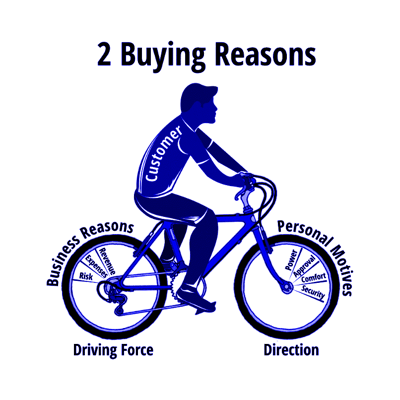
If the rear wheel of your customer’s bike is the driving force, or the business reasons, behind why your customer buys (as we discussed in Part 1), then the front wheel is the one that determines the direction in which he will go – whether he buys from you or from someone else. Here, personal motives are the deciding factor.
Part 2 - The front wheel: understanding the personal motives
Personal motives are driven by your customer’s core desires and values. There are four main categories of personal motives: power, approval, comfort, and security.
There are many subcategories to each of these, and paying attention to your customer’s comments will help you figure out what his exact motives are. Here are some of the most common personal motives and the categories into which they fall:
POWER
- Significance; feeling part of a higher purpose
- Sees the big picture
- Need to win
- Seeking more control (this is typically to minimize risk or control others)
- Revenge or to get even
- Enjoys taking risk
- Fun, Innovation
- Career advancement
APPROVAL
- Recognition from others, the need to hear “well done”
- Approval by a superior or a peer, or even employees
- Desire to be a hero
- Affiliation- being accepted by a group
- Team buy-in
- Respect by others
- Fun, Innovation
COMFORT
- Pursuing peace, reducing chaos or stress
- To love or care for another
- To be loved by another
- Seeking rest
- Religious beliefs or values
- Significance; feeling part of a higher purpose
- Aesthetics, beauty
SECURITY
- Fear – avoidance of a negative outcome
- Minimize personal risk
- Revenge or to get even
- Religious beliefs or values
Notice that some of these fall into more than one category. You’ll need to ask the right kind of question to figure out what’s really behind what your customer is saying.
How to address your customer’s personal motives for buying
To address personal motives, you first have to figure out what they are. This is a simple, two-step process.
Step 1 – Listen for keywords in your customer’s comments. Your customer will tell you his reasons; you only have to listen for hints in what he says. For instance, if a person says, “My team/boss/co-workers will really love this,” that could be a hint that approval is one of his motives. If someone says, “We are trying to reduce complexity in our expense process,” that is a hint toward comfort (less stress).
But since some of the keywords you’ll be listening for fall into more than one category you’ll need to ask the right questions to figure out where your customer is coming from.
Step 2 – Follow up with “what” and “how” questions, not “why”. When you hear clues to personal buying motives, ask your follow-up questions without using the word “why.” It insinuates motive, and your customer may not be as forthcoming as you’d like.
“How” and “what” questions are actually more effective in getting a person to reveal his or her why. Ask questions like, “When (the hint they just gave you) happens, what will it do for you?” or, “What will that give you?” Then follow up with, “And how is that important?” Their answer will give you more concrete evidence of their personal buying motive.
Conclusion
Remember that to succeed in sales, it is critical to realize that your customer’s personal motives cannot be separated from his business reasons for buying. The bicycle can’t move forward without both wheels. Failing to understand or disregarding either wheel will cause your customer to steer in another sales rep’s direction. Careful listening and framing of your follow-up questions can make you the rep who wins.

